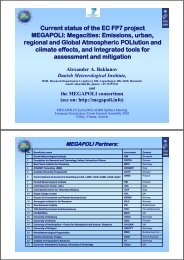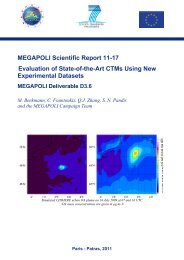D E S C R I P T I O N O F W O R K - MEGAPOLI - Dmi
D E S C R I P T I O N O F W O R K - MEGAPOLI - Dmi
D E S C R I P T I O N O F W O R K - MEGAPOLI - Dmi
Create successful ePaper yourself
Turn your PDF publications into a flip-book with our unique Google optimized e-Paper software.
<strong>MEGAPOLI</strong> 212520<br />
different levels and for the surface thermal and drag heterogeneity is needed. Recent progress in<br />
street- and urban-scale turbulence-resolving simulations has opened the way for the development of<br />
a new generation of effective urban parameterizations. The models require databases of emissions<br />
and surface characteristics as initial and boundary conditions. Feature analysis helps assessment of<br />
the megacity climate. It also relaxes the stability constraints on the megacity forcing in large-scale<br />
models. Challenging sub-grid features in the WP tasks include: spatial and temporal distribution of<br />
emission source activities; flow modification by the urban canopy structure; flow modification by<br />
the urban surface heat balance; enhancement/damping of turbulent fluxes in the urban boundary<br />
layer due to surface and emission heterogeneity; chemical modification of pollutants in the<br />
dispersion process.<br />
Methodology and Advancement Beyond the State-of-the-Art<br />
A state-of-the-art assessment will be provided of the megacity climate, dispersion of anthropogenic<br />
pollutants, fine-scale simulations with the state-of-the-art turbulence-resolving models and<br />
improved parameterizations in regional- and global-scale models. The urban models will be<br />
evaluated using WPs 1 and 3 data. Resulting parameterizations will be used in WPs 4-7. To advance<br />
current understanding of megacity features as climate forming factors, process studies will be<br />
conducted; for example, impact of surface morphology on flow near and in the urban sub-layer,<br />
which impacts the surface energy balance. Knowledge of these processes will allow computation of<br />
turbulence statistics, chemical transformation and dispersion mechanisms in the UABL. Using the<br />
3D data, the universal assumptions for evolution equations for integral turbulence measures, e.g.<br />
UABL thickness will be verified and a set of prognostic equations to parameterize those processes<br />
will be formulated. To accomplish this, the work will be divided into five tasks, with tasks 1-3<br />
providing boundary conditions for tasks 4-5:<br />
1) Surface morphology: classification and database:<br />
Databases will be compiled, which include parameters for urban morphology, land-use and surface<br />
structure. These characteristics will be derived from satellite, aerial and in situ data collection<br />
(Grimmond and Souch, 1994). The database will allow quick generation of boundary conditions for<br />
different types of models. Starting the work with existing relevant databases, it will focus on<br />
London, Paris and other major megacities in the project. The height of structures will be determined<br />
using satellite images, stereography, laser scanning and SAR-interferometry. The obtained database<br />
will be passed to other tasks of WP2 and WPs 3-6.<br />
2) Flow deformation by urban canopy in the urban sub-layer:<br />
Parameterizations of flow deformation and inter-canopy transport processes will be improved<br />
through systematic study of small-scale features of urban canopy effects on air flow. Aggregation of<br />
urban canopy properties to form a hierarchy of approaches relevant to different urban and<br />
meteorological scales will be the focus. Single or multi-layer canopy approaches will be pursued at<br />
different scales: Roughness and porosity approach (Baklanov et al., 2005; Zilitinkevich et al.,<br />
2007); Building Effect Parameterisation (BEP) (Martilli et al., 2002); Obstacle-resolved and<br />
dispersive stress approach (Martilli and Santiago, 2007). To overcome the challenges, CFD codes<br />
will be extensively is used in the development.<br />
3) Urban energy balance:<br />
For accurate physical description of the atmosphere it is necessary to model the surface-atmosphere<br />
energy exchanges. Currently available urban land surface schemes will be assessed for their<br />
suitability for different air quality modelling applications. The constraint of improving modelling<br />
performance over data requirements and computational time will be considered. The models will be<br />
evaluated against surface flux data (Martilli et al., 2002; Masson et al. 2002; von Salzen et al.,<br />
1996). The methods best to parameterize the spatial and temporal dynamics of the key physical<br />
17




